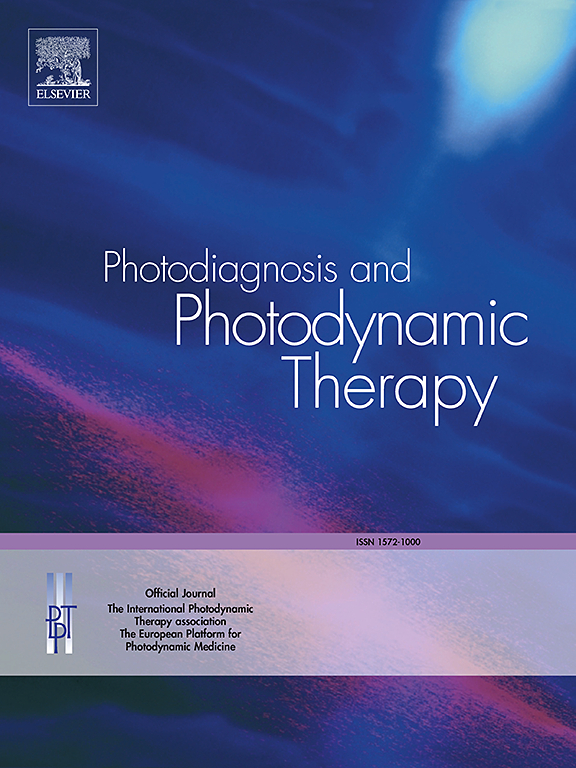Efficacy and safety evaluation of pulsed laser-activated injectable hydrogel for combined photodynamic and photothermal therapy in hypertrophic scar treatment
IF 3.1
3区 医学
Q2 ONCOLOGY
引用次数: 0
Abstract
Objective
To explore the efficacy and safety of pulsed laser-activated injectable hydrogel for combined photodynamic and photothermal therapy of hypertrophic scars.
Methods
In this prospective study, indocyanine green (ICG) was used as a photosensitizer combined with hyaluronic acid (HA) to prepare ICG-HA hydrogel, and its photodynamic and photothermal properties were evaluated. The ex vivo photothermal experiments were conducted to assess the thermal effects on tissue integrity as a preliminary evaluation of safety. Human umbilical vein endothelial cells (HUVECs) were used as the experimental cell model to evaluate the in vitro effects of ICG-HA hydrogel under different therapies. A rabbit ear scar model (n = 36) was established and randomly divided into 6 groups: ICG-HA hydrogels + single-pulse irradiation, single-pulse irradiation, ICG-HA hydrogels + continuous-pulse irradiation, continuous-pulse irradiation, ICG-HA hydrogels and control (n = 6/group). Scar characteristics were monitored at 0, 1, 3, and 5 weeks using Ultrasound Doppler, colorimetry, VSS, and SEI assessments. At 1 and 5 weeks after ICG-HA hydrogels injection, histopathological analyses (hematoxylin and eosin (HE) staining, Masson's trichrome staining (MASSON) and CD31 immunohistochemical staining) were performed.
Results
The ICG-HA hydrogel exhibited favorable photodynamic and photothermal properties while maintaining structural integrity during laser therapy. In vitro cell experiments, using CCK-8 for metabolic activity and live/dead staining for membrane integrity, demonstrated that the combined PDT and PTT treatment significantly reduced cell metabolic activity and induced cell death compared to either PDT or PTT alone (P < 0.001). In the rabbit ear scar model, the VSS results showed that at 3 and 5 weeks post-treatment, both the ICG-HA hydrogels + single-pulse irradiation group and the ICG-HA hydrogels + continuous-pulse irradiation group had significantly lower VSS scores compared to the control group (P < 0.05), with the ICG-HA hydrogels + single-pulse irradiation group showing a more pronounced reduction (P < 0.01 at 3 weeks and P < 0.001 at 5 weeks). The similar trends were observed in the SEI scores. Colorimeter analysis revealed that, compared with the control group and the single-pulse irradiation group, the ICG-HA hydrogels + single-pulse irradiation group exhibited significantly lower color difference scores at 1, 3, and 5 weeks post-treatment (P < 0.001, P < 0.01 and P < 0.001, respectively). HE staining results showed that, at 1 and 5 weeks post-treatment, the ICG-HA hydrogels + single-pulse irradiation group had the most significant reduction in scar thickness compared with all other groups (P < 0.001). MASSON results indicated that, at 1 week post-treatment, the ICG-HA hydrogels + single-pulse irradiation group exhibited more orderly collagen alignment with significant consistency and sparser collagen distribution. CD31 immunohistochemical staining results demonstrated that, at 1 and 5 weeks post-treatment, the ICG-HA hydrogels + single-pulse irradiation group significantly reduced vascular density within the scar tissue (P < 0.001).
Conclusions
The ICG-HA hydrogel can effectively and safely synergize PDT and PTT to improve hypertrophic scar conditions under pulsed laser irradiation, especially single-pulse irradiation. This approach provides valuable reference for the clinical treatment in scar treatment.
脉冲激光激活可注射水凝胶光动力与光热联合治疗增生性瘢痕的疗效及安全性评价。
目的:探讨脉冲激光激活可注射水凝胶光动力与光热联合治疗增生性瘢痕的疗效和安全性。方法:本前瞻性研究以吲哚菁绿(ICG)作为光敏剂与透明质酸(HA)联合制备ICG-HA水凝胶,并对其光动力和光热性能进行评价。通过体外光热实验来评估热对组织完整性的影响,作为安全性的初步评价。以人脐静脉内皮细胞(HUVECs)为实验细胞模型,评价ICG-HA水凝胶在不同治疗方法下的体外作用。建立兔耳瘢痕模型(n=36),随机分为6组:ICG-HA水凝胶 + 单脉冲照射、单脉冲照射、ICG-HA水凝胶 + 连续脉冲照射、连续脉冲照射、ICG-HA水凝胶和对照组(n=6/组)。在0、1、3和5周时,使用超声多普勒、比色法、VSS和SEI评估来监测疤痕特征。注射ICG-HA水凝胶后1和5周,进行组织病理学分析(苏木精伊红(HE)染色、马松三色染色和CD31免疫组织化学染色)。结果:ICG-HA水凝胶在激光治疗过程中表现出良好的光动力学和光热性能,同时保持了结构的完整性。体外细胞实验,利用CCK-8检测代谢活性,用活/死染色检测膜完整性,结果表明,与PDT或PTT单独治疗相比,PDT和PTT联合治疗显著降低细胞代谢活性,诱导细胞死亡(p结论:ICG-HA水凝胶可以有效、安全地协同PDT和PTT改善脉冲激光照射下,特别是单脉冲照射下的增生性疤痕状况。该方法为临床治疗瘢痕提供了有价值的参考。
本文章由计算机程序翻译,如有差异,请以英文原文为准。
求助全文
约1分钟内获得全文
求助全文
来源期刊

Photodiagnosis and Photodynamic Therapy
ONCOLOGY-
CiteScore
5.80
自引率
24.20%
发文量
509
审稿时长
50 days
期刊介绍:
Photodiagnosis and Photodynamic Therapy is an international journal for the dissemination of scientific knowledge and clinical developments of Photodiagnosis and Photodynamic Therapy in all medical specialties. The journal publishes original articles, review articles, case presentations, "how-to-do-it" articles, Letters to the Editor, short communications and relevant images with short descriptions. All submitted material is subject to a strict peer-review process.
 求助内容:
求助内容: 应助结果提醒方式:
应助结果提醒方式:


